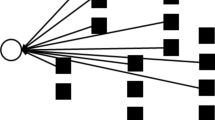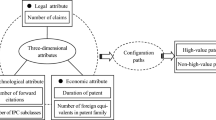Abstract
With the increasing importance of technology, the efficiency of R&D investment is becoming a critical factor to an organisation’s success. As a result, many studies have carried out to create useful information to support various decision-makings faced during R&D planning but few efforts were made to discuss technology transferability in creating the information. Technology transferability can be an important factor to increase the efficiency of R&D investment especially in a multi-technology industry, where a compound of several industries produces a variety of components and systems. Therefore, this study purposes to develop a systematic method to analyse the transferability of technology, aiming to facilitate R&D spill-over. For the purpose of analysis, patent data from USPTO (United States Patent and Trademark Office) was adopted and patent citation analysis applied, which shows the relationship between technologies and industries as quantitative measures. The research result then was applied to Korean aerospace industry and its utility verified. The suggested method is expected to be used in understanding technology characteristics and making the most use of R&D outputs by promoting technology transfer in multi-technology industries.




Similar content being viewed by others
References
Archibugi, D., & Pianta, M. (1996). Innovation surveys and patents as technology indicators: The state of the art. In OECD (Ed.), Innovation, Patents and Technological Strategies, OECD. Paris: OECD.
Bach, L., Cohendet, P., & Schenk, E. (2002). Technological transfers from the European space programs: A dynamic view and comparison with other R&D projects. The Journal of Technology Transfer, 27(4), 321–338.
Bowonder, B., Yadav, S., & Kumar, S. (2000). R&D spending patterns of global firms. Research-Technology Management, 43, 40–56.
Chakrabarti, A. K. (1991). Competition in high technology: Analysis of patents of U.S., Japan, U.K., France, West Germany, and Canada. IEEE Transactions on Engineering Management, 38(1), 78–84.
Chakrabarti, A. K., Dror, I., & Eakabuse, N. (1991). Interorganisational transfer of knowledge: An analysis of patent citations of a defense firm. Paper presented at the PICMET for Technology Management: The New International Language, Oct.
Criscuolo, P. (2003). Reverse technology transfer: A patent citation analysis of the European chemical and pharmaceutical sectors. SPRU Electronic Working Paper, 107.
Duguet, E., & MacGarvie, M. (2005). How well do patent citations measure flows of technology? Evidence from French innovation surveys. Economics of Innovation and New Technology, 14(5), 375–393.
Engelsman, E. C., & van Rann, A. F. F. (2004). A patent-based cartography of technology. Research Policy, 23(1), 1–26.
Ernst, H. (1998). Patent portfolios for strategic R&D planning. Journal of Engineering Technology Management, 15(4), 279–308.
Ernst, H. (2003). Patent information for strategic technology management. World Patent Information, 25(3), 233–242.
Evenson, R., & Putnam, J. (1988). The Yale-Canada patent flow concordance. Economic Growth Centre Working Paper, New Haven Connecticut: Yale University.
Ford, D. (1988). Develop your technology strategy. Long Range Planning, 21(5), 85–89.
Foster, R. N., & Rea, R. H. (1970). An integrated technological forecasting and R&D planning system. Semptember: Futures—An Integrated Planning System.
Granstrand, O., & Sjölander, S. (1990). Managing innovation in multi-technology corporations. Research Policy, 19, 35–60.
Hall, B., Jaffe, A. B., & Trajtenberg, M. (2001). The NBER patent citation file: Lessons, insights and methodological tools. NBER Working Paper, 8498.
Hertzfeld, H. R. (2002). Technology transfer in the space sector: An international perspective. The Journal of Technology Transfer, 27(1), 307–309.
Hu, A., & Jaffe, A. B. (2001). Patent citations and international knowledge flow: The cases of Korea and Taiwan. NBER Working Paper, 8528.
Hu, A., & Jaffe, A. B. (2003). Patent citations and international knowledge flow: The cases of Korea and Taiwan. International Journal of Industrial Organisation, 21, 849–880.
Jaffe, A. B. (1998). Demand and supply influences in R&D intensity and productivity growth. The Review of Economics and Statistics, 70(3), 431–437.
Jaffe, A. B., Trajtenberg, M., & Fogarty, M. S. (2000). Knowledge spillovers and patent citations: Evidence from a survey of inventors. American Economic Review, 90(2), 215–218.
Jaffe, A. B., Trajtenberg, M., & Henderson, R. (1992). Geographic localization of knowledge spillovers as evidenced by patent citations. NBER Working Paper, 3993.
Jaffe, A. B., & Tranjtenberg, M. (1999). International knowledge flows: Evidence from patent citations. Economics of Innovation and New Technology, 8, 105–136.
Johnson, D. K. N. (2002). The OECD technology concordance (OTC): Patents by industry of manufacture and sector of use. STI Working Papers, 5, Paris: OECD.
Jung, S., & Imm, K. (2002). The patent activities of Korea and Taiwan: A comparative case study of patent statistics. World Patent Information, 24(4), 303–311.
Karki, M. M. S. (1997). Patent citation analysis: A policy analysis tool. World Patent Information, 19(4), 269–272.
Keller, W. (2000). Geographic localization of international technology diffusion. NBER Working Paper, 7509.
Lee, G. (2005). Direct versus indirect international R&D spillovers. International Economics and Policy, 17(3), 334–348.
Lee, G. (2006). The effectiveness of international knowledge spillover channels. European Economic Review, 50(8), 2075–2088.
Park, Y., Yoon, B., & Lee, S. (2005). The idiosyncrasy and dynamism of technological innovation across industries: Patent citation analysis. Technology in Society, 27(4), 471–485.
Patel, P., & Pavitt, K. (1997). The technological competencies of the world’s largest firms: Complex and path-dependent, but not much variety. Research Policy, 26(2), 141–156.
Pavitt, K. (1998). Technologies, products and organisation in the innovating firm: What Adam Smith tells us and Joseph Schumpeter doesn’t. Industrial and Corporate Change, 7(3), 433–452.
Peretz, D. (1972). R&D and corporate planning in government. December: Futures - An Integrated Planning System.
Sa′nchez, A. M., & Pe′rez, M. P. (2002). R&D project efficiency management in the Spanish industry. International Journal of Project Management, 20, 545–560.
Scherer, F. M. (1965). Corporate inventive output, profits, and growth. Journal of Political Economics, 73(3), 290–297.
Scherer, F. M. (1981). Using linked patent and R&D data to measure inter-industry technology flows. In Z. Griliches (Ed.), R&D, patents, and productivity (pp. 417–464). Chicago: University of Chicago Press for NBER.
Schmoch, U., Laville, F., Patel, P., & Frietsch, R. (2003). Linking technology areas to industrial sectors: Final report to the European commission. DG Research, Karlsruhe: Fraunhofer ISI.
Schmookler, J. (1966). Invention and economic growth. Cambridge: Harvard University Press.
Singh, J. (2004). Innovation and knowledge diffusion in the global economy, PhD dissertation, Harvard School of Business Administration and Department of Economics.
Tijssen, R. J. W. (2001). Global and domestic utilisation of industrial relevant science: Patent citation analysis of science-technology interactions and knowledge flows. Research Policy, 30, 35–54.
Verspagen, B., Morgastel, T., & Slabbers, M. (1994). MERIT concordance table: IPC–ISIC (rev. 2). Maastricht: MERIT Research Memorandum.
Wang, E. C. (2007). R&D efficiency and economic performance: A cross-country analysis using the stochastic frontier approach. Journal of Policy Modeling, 29, 345–360.
Yamin, M., & Otto, J. (2004). Patterns of knowledge flows and MNE innovative performance. Journal of International Management, 10(2), 239–258.
Yoon, B. (2005). Methodology for managing technological knowledge and developing new technology using patent analysis. PhD dissertation. Seoul National University.
Acknowledgements
This work was supported by the National Research Foundation of Korea (NRF) grant funded by the Korea government (MEST) (No. 2009-0085757).
Author information
Authors and Affiliations
Corresponding author
Appendices
Appendix 1 The number of patents analysed in this research
See Table 5.
Appendix 2 Industries and relevant patents
See Table 6.
Appendix 3 Concordance matrix
See Table 7.
Appendix 4 Principles adopted in developing the concordance matrix
Patent classes denoted by the USPC codes are assigned to their relevant industry in the following four steps.
4.1 Step 1
Where the title of a certain USPC class is directed related to a certain industry, the class is assigned to the industry. For example, since the title of Class 105 (Railway Rolling Stock) is directly related to the I02 (Ground Transportation Machinery Industry), Class 105 is assigned to Industry I02.
4.2 Step 2
For USPC classes not classified at Step 1, if the description of a specific USPC class includes equipment and technologies related to a specific industry, the class is assigned to that industry. Where a class is related to several industries, it is assigned to the industry with the highest number of relationships. For example, the Class 188 (Brakes) corresponds to both the Industry I02 (Ground Transportation Machinery Industry) and the Industry I04 (Industrial · general Machinery Industry) but as its description mostly specifies equipment and technologies related to Industry I02, Class 188 is assigned to Industry I02.
Definition of Class 188: This class includes means for retarding the motion of or stopping machines, including vehicles, both rail and road, and shafts, wheels, pulleys, or other moving mechanisms, by friction, by positive engagement of elements, or by the internal resistance of a fluid or a field of force. Citations from other classes indicating the limits of this class will be found under the various subclass definitions.
Definition of Class 188: This class includes means for retarding the motion of or stopping machines, including vehicles, both rail and road, and shafts, wheels, pulleys, or other moving mechanisms, by friction, by positive engagement of elements, or by the internal resistance of a fluid or a field of force. Citations from other classes indicating the limits of this class will be found under the various subclass definitions.
4.3 Step 3
For USPC classes not classified at Steps 1 or 2, where most sub-classes of a specific class are directly related to a certain industry, the class is assigned to that industry. For example, the title of Class 235 (Registers) is not directly related to Industry I04 (Industrial · general Machinery Industry), and the description of Class 235 does not include equipment and technologies related to Industry I02 either, but as the majority of the titles of the sub-clauses in Class 235 are connected in some way to equipment and technologies related to Industry I02, the class is assigned to that industry.
4.4 Step 4
USPC classes not classified in these three steps are assigned to “Others”. For example, as Class 005 (Beds) is not classified to any industry even after Steps 1, 2 and 3, it is assigned to “Others”.
Rights and permissions
About this article
Cite this article
Park, Y., Lee, S. & Lee, S. Patent analysis for promoting technology transfer in multi-technology industries: the Korean aerospace industry case. J Technol Transf 37, 355–374 (2012). https://doi.org/10.1007/s10961-010-9181-8
Published:
Issue Date:
DOI: https://doi.org/10.1007/s10961-010-9181-8




